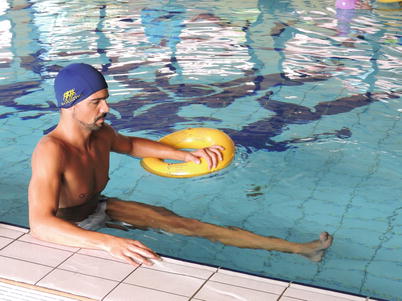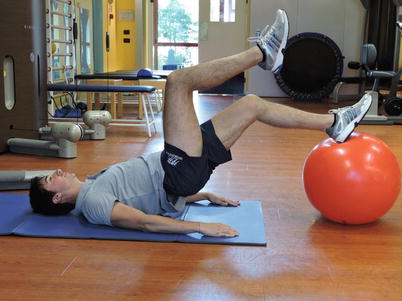Fig. 13.1
Ultrasound monitoring scheme. US ultrasound, OFR on-field rehabilitation, RTS return to sport
13.4 Treatment Strategy
The conservative treatment is the recommended approach in most of the cases; surgery is required only in rare ones, such as a total proximal hamstring rupture with tendinous avulsion [15]. We will focus the discussion on the conservative treatment.
First of all, in our vision a correct strategy also means having a proper team, proper facilities and a proper method.
The team is formed by the medical doctor, the physiotherapists and the athletic trainer. The team acts together to coordinate the process around the patient, with a constant sharing of information. For proper facilities we mean a rehab gym, pool and field. The patient will be treated with sessions in each single environment. Regarding the method, we adopt a criteria-based rehabilitation protocol that represents the current concept for hamstring injuries.
Our protocol is divided into four different stages, with specific treatment goals and progression criteria for stage advancement and return to sport (Table 13.1).
Table 13.1
Criteria-based return to sport protocol for hamstring injuries
Stage 1 | P.O.L.I.C.E. approach |
Lumbo-pelvic exercises | |
Cold physical modalities | |
Early mobilisation in the pool | |
 | Walk normally without any complaints |
Stage 2 | Stretching/flexibility exercises (static/dynamic) |
Isometric strength exercises | |
Isotonic strength exercises | |
Core stability | |
Aerobic threshold workout (stationary bike, tapis-roulant) | |
 | Running (low-intensity) forwards/backwards without any complaints |
Pain-free hamstring strength exercises/test | |
Stage 3 | Stretching exercises (continued) |
Eccentric strength exercises | |
Proprioception exercises and core stability | |
Aerobic and lactacid anaerobic workout | |
Sport-specific drills (low-demand activities) | |
FIFA 11+ | |
 | Running 20–30 m at maximal speed without any complaints |
Pain-free posterior chain flexibility test/stretching | |
Complete recovery of hamstring strength | |
Stage 4 | Eccentric strength exercises |
Anaerobic workout (especially alactacid, very high intensity) | |
Sport-specific drills (high-demand activities) | |
Sport-specific situations | |
FIFA 11+ | |
 | RTS criteria |
No US and MRI signs of muscle lesion | |
“Muscle feeling” as the contralateral | |
Complete recovery of ROM and posterior chain flexibility | |
Complete recovery of hamstring strength (isokinetic test) | |
Recovery of aerobic/anaerobic fitness (metabolic tests) | |
Complete the OFR programme |
The primary goal of rehabilitation is to return the patient to his/her pre-injury activity level as safely and quickly as possible while minimising the risk of reinjury.
13.5 Rehabilitation and Return to Sport
13.5.1 Stage 1: Protection and Optimal Loading
The main goals of this stage are reducing inflammation, protecting the injured muscle and maintaining neuromuscular activity.
In the immediate post trauma (first 24–48 h), the muscle has to be protected from movements that could potentially influence and slow down the healing process. The PRICE (Protection, Rest, Ice, Compression and Elevation) concept [16] is extensively applied. The aim of this approach is to reduce the haematoma, prevent the fibre retraction and the overall quantity of fibrous tissue neoformation [17]. Lately the rest concept has been widely discussed. It is accepted that an optimal loading concept rather than a complete rest has to be preferred. So it is suggested to move to the new acronym POLICE which represents protection, optimal loading, ice compression and elevation [18]. This is not only a new algorithm but a stimulus to think differently and customise the rehabilitation strategies to the injury severity and location. Following this idea, it is not recommended to extend the immobilisation over 3–5 days. A careful and progressive loading enhances positive effects both histologically and biomechanically [17]. So we recommend starting the first low-intensity, ROM-protected, pain-free exercises involving the entire lower extremity and lumbo-pelvic region to develop neuromuscular control. Plus, the use of physical modality such as low-level laser therapy (LLLT) and lymph draining massage is introduced to reduce haematoma and inflammation. Moreover, an early mobilisation in the pool, using high-level water, may be planned to give progressive stimuli to the healing tissues (Fig. 13.2).


Fig. 13.2
Early mobilisation in the pool. Low-intensity exercises in the pool, with optimal loading progression, may be helpful for severe injuries
The criterion to move to the subsequent stage is walking normally without any complaints.
13.5.2 Stage 2: Aerobic Threshold Workout and Running Recovery
The main goals of this stage are an initial aerobic reconditioning and the initial recovery of flexibility and strength.
In this stage there is a progressive introduction of pain-free flexibility and strength exercises, with attention to the whole kinetic chain. It is mandatory to work properly on muscle flexibility throughout different types of exercises. Both active/passive and static/dynamic pain-free stretching exercises may be used. Isometric exercises and subsequently isotonic exercises are introduced to initially restore thigh and lower limb muscle strength (Fig. 13.3). It is important to keep applying a load progression principle; moreover, core stability and lumbo-pelvic exercises are part of the protocol. An aerobic threshold low-intensity workout is initiated as soon as possible, through the activation of the uninjured muscles. During this stage the main location of the sessions is the rehabilitation gym.








